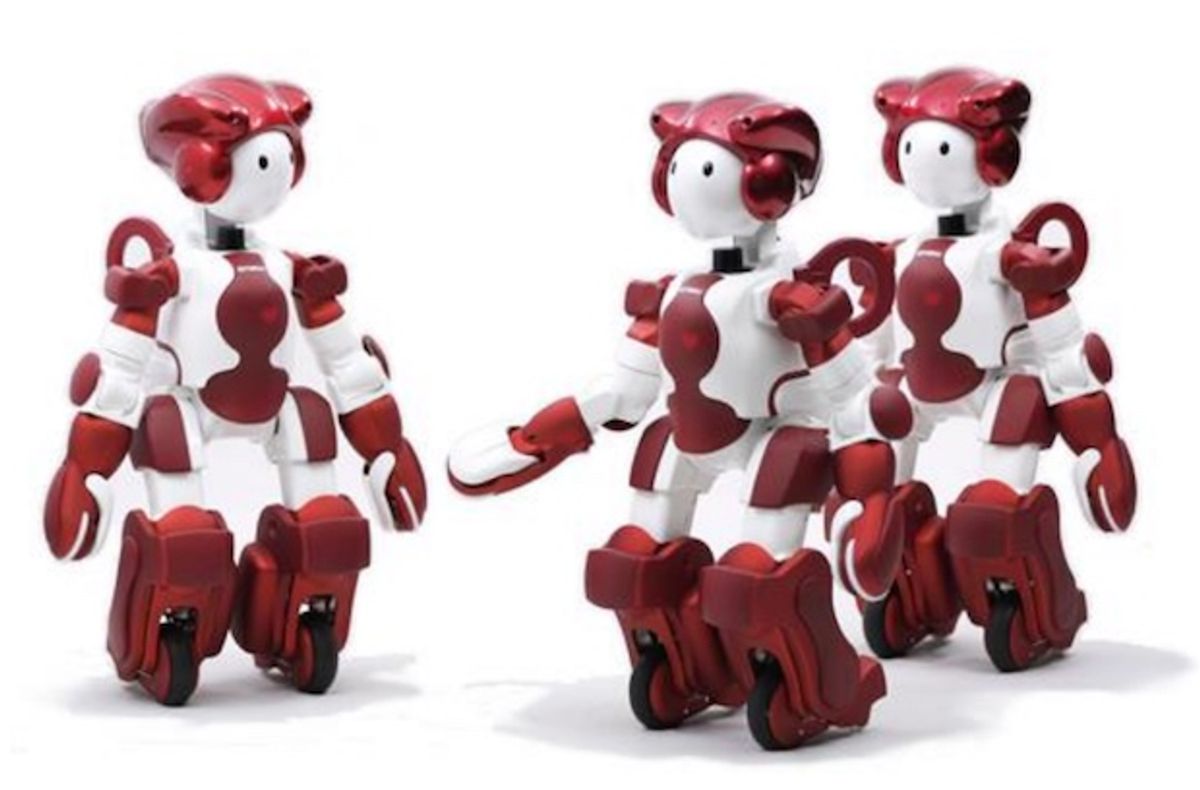I’m not sure if there’s any sort of metric for how successful Aldebaran Robotics’ Pepper robot is at working in customer service. People are certainly buying them, but by itself, that doesn’t say much about whether it works and whether people actually like it and find it effective. In any case, Hitachi wants to get a piece of whatever Pepper’s going after, and to do so, they’ve upgraded their EMIEW robot for a customer assistance role.
At first glance, the new(ish) EMIEW3 looks almost identical to EMIEW2 (which is about a decade old at this point), but the differences are significant once you notice them. EMIEW2 had single wheels for feet, while EMIEW3 uses what look a bit more like rollerblades a wheel plus a smaller caster on each foot, a design that I bet makes balancing much easier. There are also some minor redesigns on the chest and grippers, it looks like:
EMIEW2 was already reasonably capable, as robots go. Using annotated maps, it can navigate intelligently around environments that are typically infested with humans, dynamically adjusting its behavior by (for example) slowing down to go around corners so as to not run anyone over with its 14-kg frame (you can read more about this in our article from April 2014).
EMIEW3 includes some new features that Hitachi is hoping will result in “human symbiotic robots that can safely co-exist with humans, providing robot-based services with advanced communication capabilities.” Who wouldn’t want that? Here are the highlights, from the press release:
High activeness based on intelligent processing by the remote brain: A remote brain configuration was used to conduct intelligent processing such as on voice, image and language outside of the robot to enable high quality customer and guidance services. For example, by linking human movement and network cameras for environmental recognition, the robot can identify customers requiring support and autonomously initiate customer services. Further, the voice and language processing technology allows voice to be recognized and translated even with background street noise, thus supporting business in communities with a large number of tourists.
I think this just means that the robot is dependent on connectivity to do most of its interaction stuff, which is great, until it lags out because WiFi can be unreliable. See the demo below.
High operation availability of robot services: The remote operation system which monitors and controls multiple robots at different locations allows information to be shared between multiple robots and enables smooth transfer of services. Further, in the event of robot failure, restoration instructions can be sent from a remote location to quickly resume services, thus improving the operation availability of robot services.
Allowing handoffs between robots is a potentially useful feature, if it can be done in a way that isn’t a slightly confusing hassle for the user. See the demo below.
High mobility robot body capable of various services: The practical features previously developed with EMIEW2 for indoor services are kept in EMIEW3 such as its compact height of 90cm, portable weight of 15kg, ability to keep pace with humans adjusting speeds up to a max. of 6km/h and overcome differences in floor levels up to 15mm. In addition, a new ability to resume a standing position if knocked over, has been embedded in EMIEW3.
EMIEW3 looks to be more stable than EMIEW2, but it may not be statically stable, and if it’s designed to operate in crowds, that could be an issue, especially considering its small stature. Unfortunately (but predictably), this does not come up in the demo below.
And here’s a demo, which is hilarious because it features an authentically clueless American tourist:
The awkward pauses make me think that this might have been, just maybe, a real live, not pre-programmed, demo. Props to Hitachi for not completely pre-canning everything, if that’s the case.
Functionality is one thing, but for a robot to comfortably interact with people who might not be used to interacting with robots, you have to be very careful with both action and appearance. At first glance, EMIEW3 is a little weird: it’s on rollerblades, doesn’t really have a face that looks to be capable of expression, includes a pair of giant back handles (?), and features a neck that’s been unapologetically hacked out to make room for a LIDAR sensor. Say what you want about Pepper, but it has a very carefully thought-out aesthetic that seems immediately friendly, and the tablet on its chest is tacky, yes, but allows it to interact with people through touch and text, as well as through voice (which isn’t always the most reliable).
Hitachi says that it has some customers to do some proof-of-concept pilot tests, and if we’re lucky, we’ll be seeing videos of EMIEW3 interacting with real clueless American tourists, because I’m sure that would go well.
Evan Ackerman is a senior editor at IEEE Spectrum. Since 2007, he has written over 6,000 articles on robotics and technology. He has a degree in Martian geology and is excellent at playing bagpipes.




